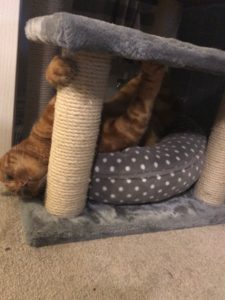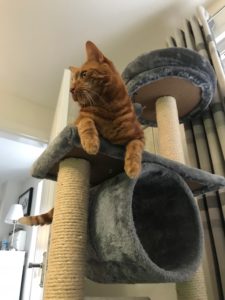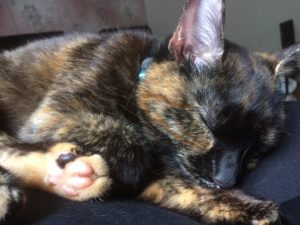Happy New Year and Happy Cats!
As the Christmas decorations are cleared we all re-position our furniture and day to day furnishings for the New Year. Now is a great time to consider how cat-friendly our homes are and take the opportunity to make any changes for our feline friends.
 how cat – friendly is your home?
how cat – friendly is your home?
Cats are wonderful creatures and make excellent companions, but let’s be honest, how many of us truly understand what makes them happy? Is giving them love, adequate food and shelter enough? Also, what does “happy” mean to a cat? If cats could talk, I would imagine that they would describe happiness as being:
- Free to make choices
- Free to hunt like a wild cat
- Able to secure a territory
- Able to predict outcomes
- In control of all resources

In a nut-shell, cats are control freaks!
In the Veterinary profession, we are taught that “Cats are not small dogs”. Sounds obvious, but we must remember that cats haven’t been domesticated for as long as dogs and aren’t naturally gregarious creatures. They have evolved to have a unique and tactical skill set that serves them well, as long as they have the correct environment. It would only take a few generations for our pet cats to revert back to their “wild” cat lives.
In general, cats lead solitary lives, which means they don’t need to learn how to share or co- operate with other feline individuals. As solitary creatures, they are self- reliant and tend to avoid physical conflict (a protective strategy).
With all this in mind, how many of us own more than one cat? Quite a few, including many veterinary professional’s, so let’s make sure that we are giving our feline friends all the space and resources they need to be happy.
- food bowl/s
- water bowl/s
- litter trays (1 each, plus 1 extra)
- scratch posts (tall enough for a cat to stretch full length)
- places to hide
- elevated perches
- toys
- beds
If we don’t provide these important things for our cats, they can become very stressed and chronically anxious. Behaviour changes include: toileting in inappropriate places, under/over eating, stress cystitis, over-grooming and becoming anti-social
Tips for resource placement
A really useful thing to do would be to draw a plan of your house, upstairs and downstairs, to work out where your cat/s spends the most time. This will give you an idea of territory. Sometimes it may seem that cats choose odd places to sleep or drink, drawing a plan will help to make sense of their behaviour.
 Always separate food from water. Cats don’t like to eat near their water source for fear of contaminating their clean water with food. This may explain why many cats won’t drink from their water bowl, but will drink from a puddle outside or your glass of water.
Always separate food from water. Cats don’t like to eat near their water source for fear of contaminating their clean water with food. This may explain why many cats won’t drink from their water bowl, but will drink from a puddle outside or your glass of water.- Position bowls away from a wall as cats prefer to observe from all directions and don’t want to worry about anyone sneaking up on them from behind.
- Place litter trays far away from food and water. Cats prefer a soft, fine substrate for their toileting. It is more comfortable for their sensitive paws. A clumping litter is good as urine can be removed very easily. Pour a nice deep layer of litter in the tray and remove any deposits as soon as you can. Clean the whole tray weekly. Remember to offer 1 tray per cat, plus 1 extra for choice.
 It’s important for cats to stretch and scratch with their claws, offer a tall scratch post near their food and also near the cat flap or where they enter or exit the house. Cats spread their smell when they scratch, to help them feel more at home.
It’s important for cats to stretch and scratch with their claws, offer a tall scratch post near their food and also near the cat flap or where they enter or exit the house. Cats spread their smell when they scratch, to help them feel more at home.- Cats love hidey holes and perches, sometimes they like to scale a room without walking on the floor, so they can avoid being “blocked” by other cats.
Making your home more cat friendly will give you and your cat/s a better quality of life, as they will be more relaxed and won’t display any of the troublesome behaviours that may cause you stress as an owner.


